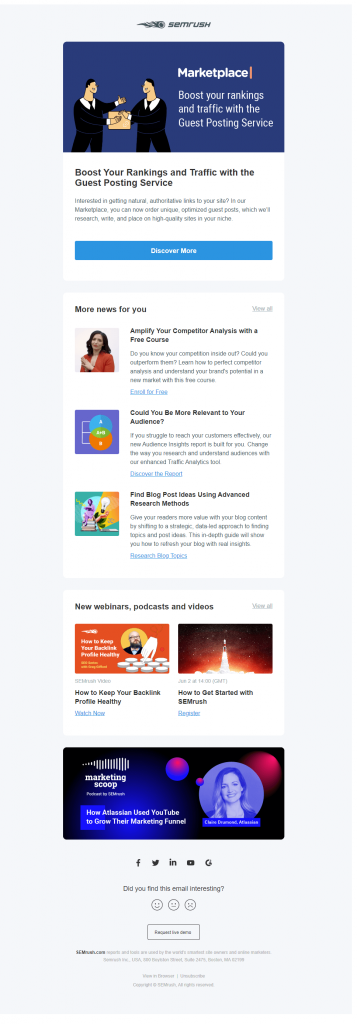What is Click to Open Rate (CTOR) in Email Marketing

Your aim for sending marketing emails should be simple – perfect deliverability, get them open by the subscribers and engage them to read the email. If you encourage them to play this full cycle, lucky you. You may get your desired email conversion in time.
In between this cycle, how do you measure the success of your email subject line and body copy? It’s the click-to-open rate. Every email must have one or several CTAs, and if only a customer clicks on one of these CTAs, you can take them to your sales page.
It’s one of the significant benefits of using email marketing is you can track all the metrics within this marketing channel to measure progress. And, the click to open rate (CTOR) is one of the most important email metrics you must look for all the time.
What is CTOR
CTOR or ‘click to open’ rate is an email metric. CTOR is the percentage of people who opened your email and then clicked a link (CTA) in that email.
So, the simplest way to calculate your email CTOR is by dividing your unique email opens by your unique email clicks and multiplying them by 100. For example, if 100 subscribers open your email and 50 of these subscribers click on a link within the email, your CTOR is 50%.
Well, let’s explore some of the needful facts and explanations to utilize this crucial email metric to a further extent.
Is CTOR Important than Other Email Metrics

There are many reasons you should care for CTOR. It’s because the click-to-open rate is directly connected to your email conversion rate. Hence, take a look at some core advantages you may avail by tracking your click to open rate well –
1. Find out the strengths/weaknesses of your email copy and subject lines
If you track CTOR and get a stable number, it will be for your quality of effective subject lines and email body copy most of the time. And, the low CTOR means you’ve had weakness in those parts of the email. Also, it helps you to set your pitch more strategically.
2. Help you with customer insights
You can track the performance of your links (or CTAs) within the email, and learn which types of links work better, and why. Also, which aren’t, and why they aren’t. This makes you rethink your email design and placement of links to make them more effective in your future email campaign.
3. CTOR helps reduce your cost per lead
CTOR provides real-time subscriber interaction to your email campaign, this eventually improves the quality of your email marketing, and you may gain more quality leads. This will save you from spending more on lead generation or any other marketing prospects.
However, all of the email metrics are crucial in their accords. Now’s the time to shed some light on more confusing parts of email performance measurement. Don’t worry, we are going to ease the confusion part anyway.
Open Rate vs CTR vs CTOR – Are There Any Differences
Open rate is the percentage of how many people opened your email out of the total email delivered to subscribers. There comes click rate and click to open rate. Many people were baffled to differentiate the two. Because both look so familiar.
Click-through rate (CTR) has been one of the most significant email metrics for many years, and Hubspot raised the question – is CTR dead? As more people were already considering CTOR over CTR.
The click-through rate (CTR) is the percentage of subscribers who clicked on at least one link in an email out of the total emails delivered. It gives you a holistic view of your overall email marketing performance. So, yes, CTR is always relevant.
But CTOR is quite different because it gives you a percentage of subscribers who clicked at least one link out of the total email opened.
That means if you send 200 hundred emails, and it delivered to 150 subscribers, the CTR gonna give you a percentage based on these total delivered emails.
On the other hand, CTOR lets you go deeper as if you are dissecting specific particles like only the people who opened your email and how many of them (these email openers) clicked on your link.
Both metrics going to give you different but interconnected insights to improve your email sending and email conversion.
What is a Good CTOR
Is there any specific number that tells you that you have a good CTOR? You can’t have a simple answer for that. Industry-wise, the good number varies.
According to My Emma, a good CTOR should be around 10-15%. While Constant Contact reported, an 11% CTOR is good enough to consider you are doing stable email marketing for your brand.
The takeaway from the above findings isn’t that complex. You need to track CTOR for each of your different email campaigns (and that’s the most intriguing benefit of CTOR). After you run several email campaigns, check all the CTORs try to find a balance between those numbers, and sort which types of emails perform best. This will give you a better understanding of your goal for CTOR.
Why You Shouldn’t Rely Only on CTOR But Other Email Metrics

Since Apple introduced Mail Privacy Protection (MPP) back in 2021, the open rate become less reliable. MPP is a feature that automatically opens all the email that comes into your system, and checks whether they are harmful or not. So, when every email opens automatically, your role as a subscriber becomes obsolete considering the open rate.
Does that mean, you should forget the open rate and any metrics related to it? Not necessarily. Click-to-open rates always remain a top priority amongst marketers, and still, it is. above.
However, to keep yourself ahead of the game, you can’t only rely on the CTOR where the open rate is somewhat shaky, you need to track other crucial metrics as well. Some of them are –
Email Conversion Rate: It’s the percentage of subscribers who complete an action that your email wanted to accomplish or point to. Suppose, you want subscribers to read a blog through your newsletter, and they clicked the CTA and read the blog. This would be a conversion point.
Bounce Rate: The percentage of emails that didn’t make it to the recipient’s inbox. This rate will let you know how many emails failed to do so, and overall email deliverability issues.
Unsubscribe Rate: It’s the number of people who once opted-in but unsubscribed later.
Overall Email ROI: Everybody knows that email marketing possesses a better ROI than any other online marketing channel. It’s the return on your overall email marketing investment. Once calculated, you’ll be well aware whether you are in good shape or your bucket has a leak.
Tips to Improve Your Email CTOR in No Time
Despite the email open rate having a troubled phase, email CTOR somewhat keeps its relevance, and marketers never lose interest in it, so should you. Here are some expert tips to increase your click-to-open rate –
1. Write Better Subject Lines
The email subject line is the first catch. A highly engaging subject line can do the trick in the first place, and provoke a customer to open and read your email content.
Read More: 13 Best Email Subject Line Tips to Increase Your Open Rates & Engagements
2. Keep Your Email Copy Precise
From the beginning of an email to the point of CTAs, email copy is the only thing you can rely on. A perfect and engaging email copy does the job with ease, impresses readers, and increases your click-to-open rate. While writing your email copy, try to write in a language measured by the type of your email, never lose weight, and don’t spend a single word that feels extra.
Also, Check Out: 7 Email Copy Writing Tips You Should Know to Write Winning Emails
3. Use Dynamic Content in Email

While writing your email, don’t rely on over-used or cliched stuff. Check your customer interaction data, try to connect with their pain point, and fresh information to light up their reading experience. Providing real value not only gets you real conversion, but it will add up to your sustaining brand image.
4. Create Personalized Email CTAs
Call-to-action is a clickable button or link in your email, that leads a customer to an action you designed for them to complete. The average click-through rate of CTA is 3-5% (databox), and a personalized CTA is better than plain CTAs (Hubspot). So, you should go for a personalized one to improve your CTOR.
To learn the better use of email CTA, you can follow through industry best practices for CTA.
5. Implement an Email Analytics Rool and Review Your Results
With weMail, you can easily use the email analytics feature to track all of your email metrics, follow up, and analyze email performances. This review system is all you need to improve the part where you lack and proceed to more successful email campaigns.
Closing Up
Even in this age of AI, where marketing channels revamping their working process, email marketing still tops the chart regarding higher engagement and conversion. With the help of AI email writers, you can even do things faster.
For tracking email CTOR, and other email metrics – an automated email marketing platform like weMail can be a life lifesaver, and its highly customizable automation features and template library only get you closer to your goal.



